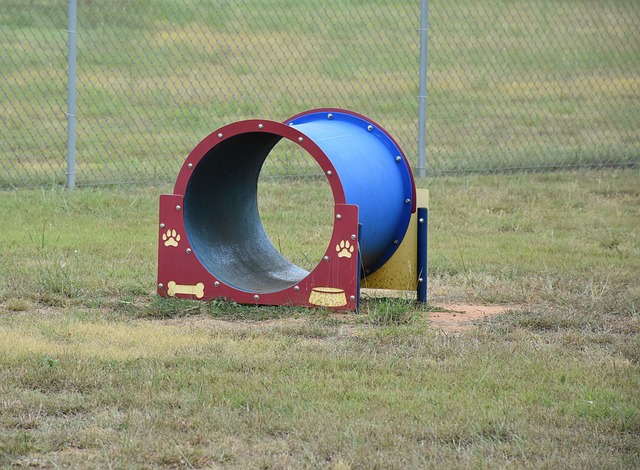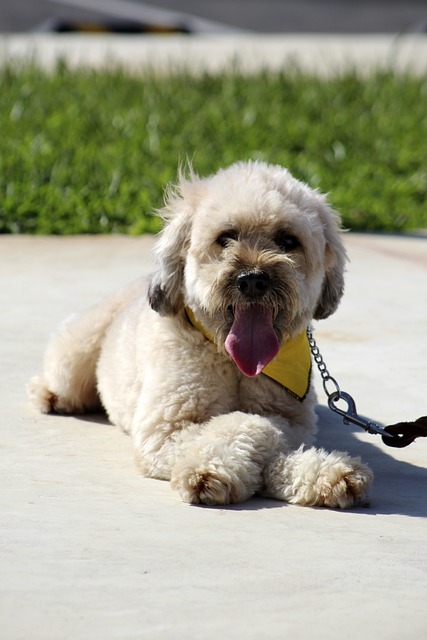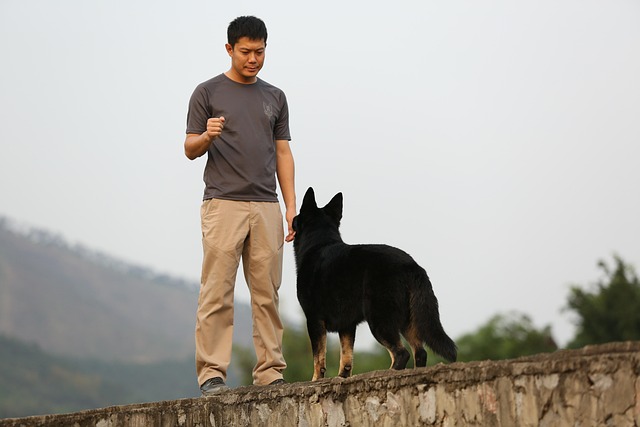Great Tricks To Train Your Dog Easily

Dogs undergo all types of training for several reasons. Dogs are trained as assistants to the handicapped or ill, some are trained as specialized hunting dogs, work, pleasurable house pets. Dogs are well known for their master. That is what makes them a great pet. This article gives tips for training your dog.
You can try a little bit of ingenuity if you are going with crate training for your indoor dog or puppy. If your puppy doesn’t like being in his crate, put a dog treat or chew bone in it and close the door to keep him out. The dog will smell the bone and want to go racing into the crate to eat it. After he goes in the crate, reward him with praise and a treat.
There are many different approaches that can be used to crate training your dog easier. When they go inside to get the bone, shower the dog with praise.
Try to see things from your dog’s perspective. It’s easy to get mad if your dog is not doing the basic things you teach it. Rather than giving up completely, you should try seeing things from your dogs perspective. Imagine the world like they do and that can provide you with a fresh perspective on training.
Try to view things from your dog’s eyes. Frustration can be easily acquired if the dog does not pick up your training of basic things in a rapid manner. Don’t give up- think instead.Looking at things with this fresh mindset can help you new and effective ways to train your dog.
To keep your dog compliant with his training, be sure to continue the process well after he has performed the way that you have hoped. People think that just because their dog has been trained once, that is all they need. Don’t allow your dog to get out of the habit of good behavior. This is why you must make sure that you have a rule system that is strict for your dog.
Make sure that you remain controlled when rewarding your dog. When your dog responds to a command in the right way, try to keep them calm as you give them their reward. If you get excited, the dog will become that way too.
Be prepared to reward the dog as soon as it completes a positive behavior. It is important for the dog to realize when he exhibits the proper behavior in response to your commands. By rewarding your dog after it does something you want, it will realize that it’s doing a good thing. Therefore, it will be more likely to continue this good behavior.
Give your puppy with lots of chewable toys, and keep him away from chewing other items. Give the dog one of his toys instead.
Patience is definitely a virtue when training your pet. Patience helps avert anger and frustration throughout the training process. It takes time for your dog to learn what is expected from him. Understand that your dog wants your approval and is doing his best to earn it.
A dog will look at one thing until you divert its attention is broken. If you are consistent and use repetition, your dog will look to you more often for direction rather than looking to the environment.
When training your dog, keep track of time during each session. It is possible that your dog will lose interest if it is made to do the same thing over and over. Keep sessions to a minimum at first. Target 10 minute sessions for increased success.
Repetition is the key to teaching a dog a new command. It is not uncommon for it to take between 25 to 50 repetitions to learn a new command.
Training methods you use should be consistent. If more than one member of your family is training your dog, be sure all people use the same commands, rewards and discipline. Use the same phrases and commands in every training session with your dog to avoid confusion.
Limit the time of training sessions. Spending too long on training exercises will bore the dog. Keep the lessons to 10 minutes or so.
Keep your eyes on other dogs as you walk your own. Some dogs may be aggressive regardless of how responsible the owner is. If you see an antisocial or aggressive dog, avoid having your dog be near it.
If your dog wants to jump you should squeeze their paws when they do so, hold his paws and squeeze them a little so he will know this is not acceptable. This will not hurt him, but it will impart the information that jumping up is not appropriate. They should learn to avoid doing it in order to avoid the reaction they get.
When your dog is displaying unwanted behaviors, use water to spray him. This lets your dog know that specific actions are not acceptable. In no time you will have a well behaved pet of which you can be proud.
Always get your dog’s attention by doing the same thing. Start your commands by using his name. Get is attention by using its name and make it follow what you want them to do. Dogs tend to respond to names immediately and they know you want their attention.
For every time that you say your dog’s name when correcting behavior, you should say his name several other times using a more positive tone. Your dog will obey a call to its name and come when you call only if the name is associated with good things.
Try to keep accidents at a minimum when toilet training your dog without there being any accidents. Watch your dog and learn the signs that he is ready for a trip outdoors. Don’t delay if you see your dog is doing these things. Grab a leash and bring him to the spot where he uses the bathroom. Reward your dog for using the bathroom outdoors.
Early in your training, when your pet does something you want him to, give him a treat. Slowly remove the treats bit by bit and replace them with a toy or belly rubs.
To prevent your dog from barking, try to understand what is causing it. It could be a noise or simply coming into contact with other animals or people. Your dog should realize barking is unnecessary in reaction to these triggers.
To achieve results when training for obedience, it is necessary to routinely spend sufficient amounts of time on the task at hand. A regular, consistent training program will make it easier for a dog to learn. Also, just spending time with the dog daily is a great way to engender confidence and true friendship. These two things will work in order to make it know that you’re the leader.
Use a steady and commanding tone when you are correcting your pet. Dogs pick up cues from their owner’s voices. An appropriately stern tone can really reinforce their discipline.
Your older dog may have limitations due to age and illness that prevent it from doing all of the obedience tasks of a younger pup. If your pet has problems with their bones or muscles, you should not expect them to be very active. Training is good for keeping a dog’s brain active, which is helpful to old dogs. Be sure to choose training methods and activities that take problems such as arthritis into account.
Use different tones of voice when training your dog. Be firm with your command, but vary your tone depending on what you are trying to get the dog to do.
Reinforce your dog’s positive behaviors. Ignore his negative behaviors. If you yell and scream, your dog may become very frightened of you. Your dog will be more likely to behave if he knows he will be rewarded.
One trick to remember when training your dog is to be sure that you introduce it to different social environments early and frequently. Your dog must know how to behave in the company of other humans and dogs as well as humans. This will help to reduce sporadic behavior in social environments.
Introduce new animals to one another very slowly. Before you bring a new pet home, think about the pet you already have. You can boost bonding efforts by getting a new pet that has a complimentary personality to your own.
A good training trick is to know the special grooming needs that your dog needs. Some dogs require a small amount of grooming, whereas other breeds need meticulous grooming weekly. Grooming keeps your pet clean and happy, happy dog which can also provide health benefits.
Deal with boredom barking. A dog who barks when bored has an owner who is not attending to its needs. This is a sign that the dog lacks suitable outlets for his energies. Spend time playing with and walking the dog. If you can’t be around, leave your dog some chew toys.
Do not punish your dog any punishments when you are training him. Try to make every attempt to prevent any bad behavior before it happens, but if it does happen, show your dog what he should have done.
Look for positive reinforcement methods that allow you to train your dog without the use of treats. It does work to give dog treats when they learn a new behavior. However, you won’t always have dog treats on you when training in a more unstructured setting. Petting and showing love to the dog are also good ways to reward your dog. You can use these kinds of positive reinforcements to encourage good behavior in addition to treats.
Realize an older dog. Older dogs are unlikely to be completely trainable, as they are going to have minor quirks you should just learn to live with. Although you can teach them some new tricks, sometimes the best thing to do is focus on the negatives that you want to modify and live with the rest.
You will want to get your dog ready early to go to the vet. Touch your dog gently down the sides of his body and tell him he is being good when he does not react. Help him to tolerate the vet handling his paws and mouth. See if you can get friends or family members to help you.
Consistency is key to successfully training your dog. Consistency means not only consistent word choice, the tone of voice you use when saying these words and the rewards that you provide for the dog when it successfully complies with your commands.
Dog training is a daily process that needs to be ongoing. Teach your dog good behavior throughout the day like sitting for food and barking to go outside. By constantly reinforcing lessons, your dog will learn that all commands are applicable in all situations. If you are not training them all of the time, they might only do things at a certain time.
Always discourage unwanted behavior you see. Say no with a strong voice. Do not yell and/or hit your dog despite any mistakes it does. Discourage incorrect behavior as soon as it happens. Dogs can’t remember things for long. If you wait, your dog will not understand what you are doing.
Be consistent with the words you use when trying to teach your dog a new behavior. A dog will respond to this positively, as they will start to associate that action or word with each kind of behavior. Consistency is very important. By being consistent, the chances of successfully training your dog are much greater.
For example, an easygoing dog is sure to do well with positive reinforcement, while aggressive dogs might require negative reinforcement if they are to acknowledge your role as leader. If the training method you have chosen is not functioning, try something new.
When you want to have success at dog training, understanding what your dog is motivated by is half the battle. You will also get educated about what your dog likes or doesn’t like, and what will work and what won’t. Offer your dog different training regimens, positive reinforcement and lots of love while training him. Happy dogs tend to perform better, and are easier to train successfully.
As previously stated, dogs are trained for many reasons. Dogs are very well known for how much they wish to please those around them, which makes having one trained in that manner a good dog to be around. If you put the information in this article to use, you will find training your dog to be easier than you thought.
One of the most important part of dog training is communication. Make sure you are clear and consistent when you are working with your dog. This includes both your spoken words and body language. Your choice of rewards and punishments should also remain consistent. Remember to always pay attention to the communication signals from your dog. If the dog is feeling happy and playful, or stressed and overworked, he will communicate this to you in his own way.


